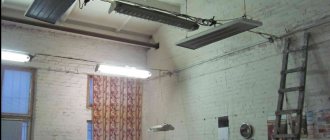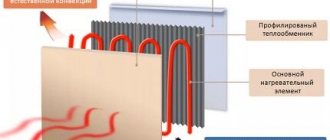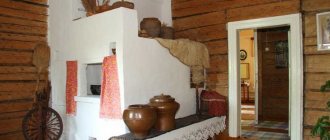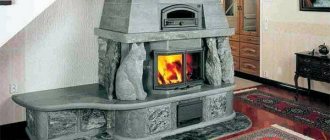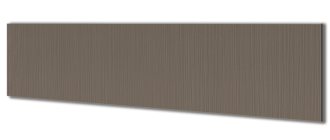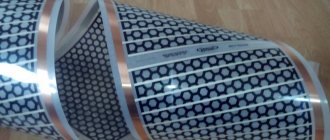Home » Equipment » Heating radiators
It is impossible to imagine life in a country house or in an apartment without centralized heating. It entered our reality so tightly and brought a lot of comfort. But due to various factors, this type of space heating sometimes does not cause positive emotions, or is absent altogether. And then modern technologies take over, one of which can be considered infrared heating.
Infrared heating radiator
The method of heating with infrared rays came to us not so long ago. But even under this condition, its distribution is expanding very quickly. For this reason, the manufacturer is trying to modernize old models and come up with new, more advanced and more comfortable ones.
As a stationary device, you can’t think of anything better than infrared radiators. In use, you don’t have to worry about their safety and, compared to other electrical devices, they have many advantages.
Principle of operation
Our Sun emits infrared waves in different spectrums - near, middle and far. Radiation with a wavelength of 8–14 microns is considered the most effective and safe. It is used in the production of equipment for infrared heating at home. Essentially, these heaters are a small sun that runs on electricity. Unlike conventional radiators (oil or electric), they do not heat the air - the radiation only heats the objects it hits, and these same objects become a source of heat. It is from them that the air in the room is heated, so the surfaces in the equipment operating area are always warmer than in other areas of the room.
pros
When compared with traditional heating methods using convectors and oil radiators, the infrared panels in question have a number of advantages:
- Fast heating. When the equipment is turned on, the temperature in the area of its operation rises after 1–2 minutes. This is due to the fact that the rays are not scattered in the air, but reach their direct destination with little loss.
- Quiet operation and environmental friendliness - the operation of the equipment does not produce any sounds or vibrations. During the heating process, no harmful substances are released that could harm residents. Also, film infrared heating dries the air to a lesser extent, since heating occurs not from the hot surfaces of the radiator, but from warm pieces of furniture, walls, and floors.
- Wide application - these systems can be used not only in the home, but also in industrial premises, garages, utility rooms, and on the street.
- Effective air heating. Conventional radiators heat air, which rises, cools and falls down. As a result, the temperature at the feet is always lower than at the ceiling, which is not entirely correct. Infrared heaters direct rays from top to bottom, as a result of which the floor and pieces of furniture below are heated - heat emanates from them, so the air temperature below will be approximately equal to the temperature above. Also, convection currents (air circulation) are noticeably weaker.
- Unlike conventional electric convectors, infrared systems do not burn oxygen and do not dry out the air.
We can talk for a long time about the advantages of these systems.
Areas of application
Due to the many advantages available, heating equipment with infrared radiation has a fairly wide range of applications. It has found its place in production areas due to its efficiency and economical use. Homeowners found in these devices such qualities as easy installation and free design.
In apartments it is not used constantly, but between seasons. That is, when it’s not quite warm outside yet, but the central heating has already been turned off. In rural areas where there is no gas connection, the only alternative is electric infrared heating. Of course, you can connect any other electrical equipment, but IR heaters are much more economical.
Summarizing all of the above, we can conclude that wall-mounted IR radiators are the most modern devices and are not inferior in efficiency to other electric heaters.
YouTube responded with an error: The request cannot be completed because you have exceeded your quota.
- Related Posts
- Which central heating batteries to choose?
- How to repair a cast iron heating radiator with your own hands?
- What are the best radiators for central heating?
- What characteristics are used to choose autonomous heating batteries?
- Is it possible to install bimetallic radiators on central heating?
- Is it possible to install aluminum radiators on central heating?
Versatility, health benefits, safety
Nobody bothers you to combine infrared heating batteries with conventional radiators - they can complement each other. With minimal effort, you can create a “warm island” in your home by installing 2-3 simple heaters, which will be directed to the kitchen corner, for example, or to the sofa. They are often installed in gazebos on the streets or in verandas. This will allow you to sit outdoors even in relatively cold weather.
Installation of infrared heaters is extremely simple - they can be placed on a special leg, hung on a wall or attached to the ceiling. They plug into an outlet and are immediately ready to use.
It is believed that infrared heating systems are more beneficial for human health. The sun's rays, when they hit a person's skin, penetrate inside and heat the blood vessels, causing heat to quickly spread throughout the body. However, there are often disputes that infrared heaters are harmful to health, which is not true. According to research by Japanese scientists, these devices serve as a preventive measure against many diseases.
What are wall-mounted infrared heaters?
The wall-mounted infrared heater has revolutionized the world of heating devices. The device is mounted vertically, is compact, but quickly creates a comfortable temperature. Infrared heat radiation can be compared in principle to the sun's rays - it heats objects within its radius of action, which, by giving off heat, increase the temperature in the room.
In everyday life it is sometimes inaccurately called a reflector. In addition, the device is very economical, easy to install and connect, and has an attractive appearance.
Minuses
This equipment has not only positive qualities. There are also disadvantages:
- Spot action of the heater. If it works in one place, then the heat will be there; in other parts of the room the temperature is lower.
- Taking into account the fact that the rays of the heater pass through the air and warm the furniture and things that they fall on, it is possible that a plastic smell may appear. This is possible if the heater is directed at the chair on which the TV remote control is lying.
- Aesthetics suffer in some cases. Portable or even film heaters do not always fit aesthetically into the interior.
- High price of the equipment itself.
Considering how much an infrared heater consumes (depending on the power, consumption reaches 0.5–1.5 kWh or 50–200 Wh/m²), it cannot be called energy efficient. In terms of energy consumption, these devices are almost no different from conventional oil radiators or convectors. Efficiency can be achieved by insulating the room and installing heat-reflecting screens, but this is also possible with conventional radiators.
Types and types of IR heaters
Depending on the object of application, the required characteristics, power and temperature conditions, various types of infrared heating can be used. We will look at the most popular ones.
Spot type
Can be used as part of the interior. They look like fluorescent lamps and can be mounted in different places on the bracket. They heat a small part of the room and are used locally. The only drawback of such infrared heating is the price. But in terms of the energy spent on heating, this type pays for itself quite quickly and is still beneficial as an addition to the main system.
Film type
Special IR film is installed under the floor to heat it or on the ceiling. This film does not affect the functionality of the equipment, and the room heats up evenly. This film can also be used as local mobile heating, in the form of a mat. Very convenient for creating a workspace or in the bathroom. IR film can be installed under any coating, even cement screed. Ideal for use in residential areas.
Heating drywall
This is the name for infrared panels built into a wall or ceiling with plasterboard finishing using the frame method. On the back side of the finish there are electrically conductive carbon threads, which are additionally insulated with a polymer coating for heat reflection. These panels are indispensable in the interior. They can be easily used for repairs, just like regular drywall. And by the way, it is recommended to install such infrared heating as backup heating to the central system.
Ceiling panels
Infrared heating of this type is considered the best of all available types today. Mounting on the ceiling does not create any inconvenience with repairs or interiors; the radiation comes from top to bottom. Can be installed in separate zones. For example, in a workshop, when you only need to warm up the workspace, without the area where the machines are located. At the same time, the floor and walls can be used more functionally.
The panel is a compact device, painted with powder dye, and placed in a metal case. Such devices can be installed under any non-stretch ceiling covering. IR panels are almost invulnerable to accidental damage; only water leaks in apartment buildings can be dangerous. And one more disadvantage - such devices heat up household appliances, which can damage them. Therefore, you need to use it rationally and carefully approach the issue of choosing power.
Ceiling IR heaters with water coolant
Warm or hot water (temperature from 40°C to 120°C) is used here as a coolant; it transfers heat to the pipes and the radiating screen. This type of infrared heating is used in industry. Can be used as an alternative energy source. Can also be used in air conditioning mode.
Wall IR panels
They are less efficient than the floor and ceiling type, because heated air, according to physics, always tends upward. Efficiency decreases and energy costs increase slightly. But still, in comparison with electric heating, it is many times more profitable. Wall-mounted IR panels can be used as an additional source in particularly cold areas.
Gas IR heaters
This type works by heating plates made of a heat-resistant composition, inside which an air-gas mixture is burned. Their power is the highest, so the use of this type in residential premises is contraindicated. In addition, the price of such infrared heating is quite high, which makes them in demand only in industrial enterprises or in large facilities such as a shopping center or sports ground.
Varieties
There are three types of infrared heaters: film, panel, stationary. There are design features between them. Stationary ones are the simplest. These are separate devices that are installed on a leg (or attached to the wall) and plugged into a free outlet. They can be directed to the sofa, and then moved and plugged into another outlet.
Film and panel ones are not mobile. The latter can be installed in the ceiling or on the wall, while film ones can be installed on the ceiling or floor. Each type has its own characteristics.
Panel
When organizing infrared heating of a private house or apartment, panels are more often used, and films are less often used. Flat panel equipment allows you to save room space, as it does not involve changing the height of the room. This is a relevant solution for rooms with low walls.
They consist of:
- Heating element - heating element. It is made from one of three materials: quartz, ceramics, tungsten.
- A special panel that receives heat and transfers it to objects in the room.
- Insulation on the back side. It reflects heat waves from the back of the device and eliminates heat loss.
- Cases.
Infrared panels can be built into the ceiling or hung. Built-in ones are more popular and aesthetically pleasing. In this case we are talking about infrared plasterboard heating with special thermal insulation and graphite thread. They are also built into the walls around the perimeter of the room. Each panel has an average power of 150–200 W.
Film
This type of heater is ideal for organizing a warm corner somewhere on a loggia or veranda. It is used for zonal heating, although no one bothers to cover the apartment with “warm films” over the entire area.
In film infrared heating, the main material is a thin layer of graphite, which is applied to a thermoplastic film. Instead of graphite, a carbon thread can be used - when heated, it creates a heat flow. Note that film heaters create a single integral system, but it consists of separate modules. If some section fails, it is not difficult to replace it with a new one without compromising its integrity.
These panels do not have high power, so their efficiency is low. For this reason, they are used for local heating and are rarely installed along the entire perimeter of the apartment.
Danger of use and harm
People who choose a heating system want to know whether infrared heaters are harmful. If a person falls asleep on the beach, he can “burn” his skin, his temperature will rise, and even a serious burn is possible. The same is true with infrared heaters - if the panel or mobile equipment is directed at the sofa, then dozing on this sofa is dangerous to health (a person may overheat).
The biggest harm of infrared heating is drying out the skin. With prolonged contact of the skin with infrared rays, the moisture on the human body evaporates, and its replenishment is not carried out immediately. In extremely rare cases, this can lead to a burn (sleeping with the heater on), but more often than not, people’s skin simply dries out.
There is also information that infrared waves somehow affect the protein contained in the skin, and with prolonged exposure, such a heater harms the eyes: first of all, the retina suffers, and secondly, the lens. Sometimes the appearance and development of cataracts in people is associated with infrared heating, although all this has not been proven and is hardly true. Such damage can only be caused when the heater power is very high and a person remains under the waves for a long time.
Connection
It’s not hard to figure out how to connect an infrared heater - it operates on a 220-230 V network, so the simplest and most obvious way is to plug it into an outlet. At least, mobile models are connected to sockets.
Panels or film systems are connected to each other in parallel, then connected to the thermostat (control panel), after which the wire (phase, neutral and ground) is pulled directly to the machine located in the distribution panel. This allows you to bypass all the wiring brought into the apartment or house. Most often, a separate automatic machine is installed to heat the apartment, which is triggered when there is a heavy load or a short circuit. The rest of the wiring in the apartment is connected to another machine. This allows you to correctly distribute the loads generated during the operation of infrared heaters. If you “hang” a powerful heating system on the existing apartment wiring, then when the heating system and, for example, an electric oven, air conditioner or iron are operating simultaneously, overloads are possible. In rare cases, this leads to a fire, although most often automatic devices are triggered.
However, to create a cozy warm corner with a small number of panels with a total power of up to 2 kW, it is possible to connect an infrared heater to an outlet, that is, the general electrical wiring in the house.
Best models
Various manufacturers in Europe and Russia produce home heating equipment. In this rating of infrared heaters, the best models that have collected positive customer reviews are selected.
1st place - Ballu BIH-AP4-0.8-W
The cost of this model is around 3000 rubles. This heater is designed to heat an area of 16 square meters, connects to a 220/230 V system and is installed at a recommended height of 2.4–3.5 meters, its power is 800 W.
Based on reviews, we find out that this is an effective and high-quality model that warms up the room quickly enough. The set includes durable brackets - with their help the device can be rotated. This model is mainly used as an additional source of heating in any room, but is also suitable for a garage and for installation outdoors - the waterproof housing will not allow rain to spoil it.
2nd place - Almac IK5
This infrared heating battery has a lower power of 500 W. It effectively heats 10 square meters, so in a single copy it is used as an additional heat source. However, three similar models can easily cope with heating a large living room or hall.
Judging by the reviews, the device effectively copes with its task, is easily attached to the wall or suspended from the ceiling, and is simply adjustable - it is enough to set 23 degrees during the day, 20 at night. The only drawback is the complexity of the connection. And although the instructions indicate how to install an infrared heater, the kit does not include wires and a thermostat, so without the appropriate knowledge and experience you cannot connect it - you will have to call a specialist, but you can turn a blind eye to this, given the low price of around 2,500 rubles.
3rd place - Peony Thermo Glass P-10 (7000 rubles)
The model is from the Russian one, which has become popular on the Russian market. Power – 1000 W, heating area – 20 m². The device is connected via a regular 220/230 V socket and is equipped with electronic control and a thermostat, which allows you to accurately regulate the power and heating temperature. It also received protection against overheating, which ensures minimal safety and increases its service life. The infrared heater can be installed on the ceiling at a height of 2.3–3.5 meters.
According to reviews, the model is effective: it quickly heats surrounding objects, operates silently and provides soft and pleasant warmth. This is an advantage, since some models heat aggressively.
The disadvantage is the equipment and high price. The model is significantly more expensive than similar heaters, and the kit does not include any cables. The device also needs to be looked after - if you do not systematically wipe the dust off it, then over time a burning smell will appear.
There are also many low-quality products on the market with the CE mark. In one case it means “Conformite Europeenne”, in the other it means “China Export”. Try to choose reliable equipment, since heating devices in the house always pose a certain danger.
Calculation of IR heating project
Only a specialist can make accurate and high-quality calculations when designing a heating system. But you can get approximate figures for infrared heating yourself. The following indicators are important in this matter:
- total power for heating the room as a whole;
- power density (its required amount per square meter)
- degree of comfort (temperature regime acceptable for residents).
Thermal insulation indicators must take part in the calculation. For non-professional calculations, you can rely on your own feelings.
Let's take a small cottage with an area of 200 m2, the owners of which feel comfortable at 190C. The house is built of sand-lime brick, double-glazed windows are installed. Heat loss in a home is average; a power density of 100 W/m2 is sufficient. The total power for heating it will be 2000W. It should be borne in mind that with an average value of heat loss, this value must be multiplied by a reduction factor of 0.85: with infrared heating, the temperature is felt 3-4 degrees higher.
The height and location of installation of the heating device is important. If the owners decided to place them on the wall at a height of 2.5 m from the floor, then it will be able to heat 8 square meters of area. In the ceiling installation option at a height of three meters, the volume of heated meters would increase to 24, which significantly reduces the number of heating devices in the project.
The level of heat and electricity costs depend on high-precision calculations, and it is best to entrust this work to specialists.


